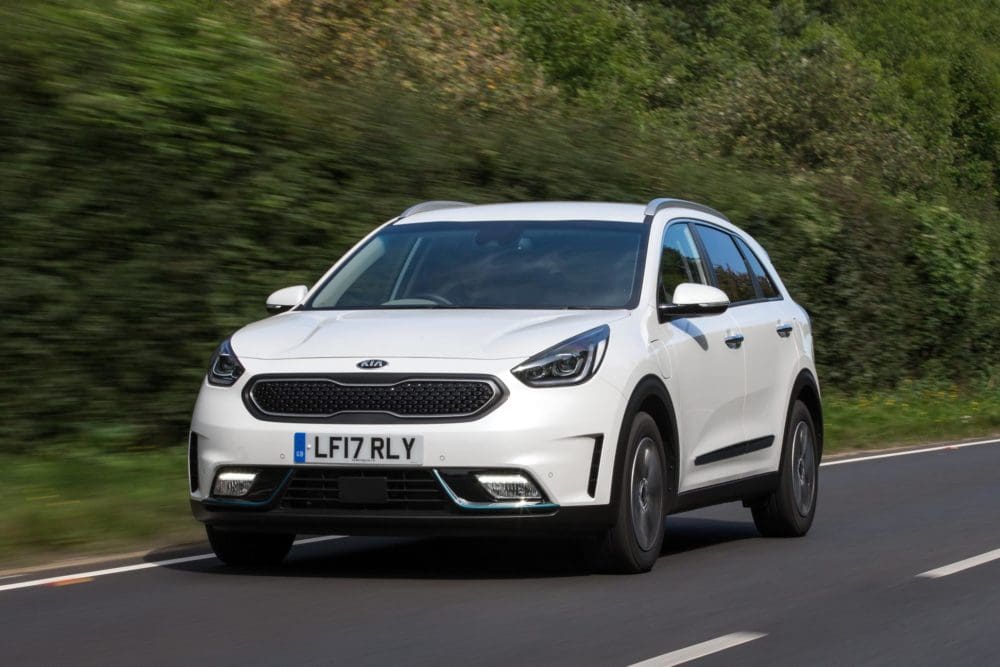



The new models join the all-electric Soul EV, and the existing Niro hybrid in helping to drive Kia towards its goal of a 25 per cent reduction in fleet average CO2 emissions by 2020, based on 2014 figures.
Kia says that with potential fuel economy of well over 200mpg and CO2 emissions of just 29g/km, the Niro PHEV is easily its most efficient car to feature a combustion engine ever.
The PHEV is a stand-alone model in the Niro line-up, based on the mid-range (grade 3) Niro parallel hybrid (with ADAP). It is available in six colours, including optional Gravity Blue which is exclusive to the plug-in Niro. The standard paint colour is Rich Espresso, while other options are Clear White, Graphite, Midnight Black and White Pearl.
The Niro PHEV features the same 1.6-litre direct-injection petrol engine as the parallel hybrid, but in the plug-in model this is paired with a more powerful 44.5kW (60bhp) electric motor. The Niro PHEV is capable of travelling up to 36 miles on the energy stored in its batteries, which means many owners will be able to complete their daily commute without using a drop of petrol or producing any tailpipe emissions. The petrol engine is an Atkinson cycle unit.
The 44.5kW (60bhp) electric motor is powered by an 8.9kWh lithium-ion polymer battery pack rather than the 1.56kWh system in the parallel hybrid. The Niro PHEV can cover 0-60mph in 10.4 seconds and has a top speed of 107mph.
The greater energy storage capacity of the PHEV’s batteries allows the car to travel up to 36 miles on electric power alone. As a result, its official CO2 emissions figure is just 29g/km, so business users pay only 9 per cent company car tax in 2017-18, while the certified fuel consumption figure is 217.3mpg. A brake energy recovery system recoups energy normally dissipated as heat and stores it in the batteries for use later.
Drive to the front wheels is through a six-speed dual-clutch automatic gearbox (6DCT) rather than the continuously variable transmission (CVT) used by most hybrids. A Transmission-Mounted Electric Device (TMED) allows the combined 139bhp of the two power units to be transferred to the drive wheels simultaneously, with minimal energy losses.
The Niro’s platform has been engineered exclusively for electrified vehicles and has been designed to accommodate present and future electrical components within a compact vehicle footprint with minimal intrusion into the spacious interior and luggage area. In the PHEV, luggage space has been slightly reduced to 324 litres to make space for the enlarged battery pack, but this has been partially offset by a reduction in the size of the petrol tank from 45 to 43 litres.


The Sportswagon PHEV can travel up to 38 miles in all-electric mode (saloon 33 miles). Its CO2 figure of just 33g/km (saloon 37g/km) means company car users pay just 9 per cent benefit-in-kind taxation in 2017-18, the same as with the saloon. The Sportswagon’s combined fuel economy figure is 201.8mpg (saloon 176.6mpg).
Packaging of the batteries in the boot floor, plus a 15-litre reduction in fuel tank capacity, ensures the Sportswagon PHEV is as practical and versatile as it is efficient and clean. It can carry 440 litres of cargo with the 40:20:40 split rear seats upright, or 1,574 litres when they are folded, and it has a payload of 390kg.
As with the Optima saloon PHEV, the Sportswagon PHEV combines a 154bhp 2.0-litre direct-injection petrol engine with a 50kW (67bhp) electric motor. The motor replaces the torque converter in the six-speed automatic transmission. When working together, the combustion engine and electric motor generate 202bhp. A package of aerodynamic, styling and technology features contributes towards the Optima Sportswagon PHEV’s low CO2 emissions and fuel consumption. The most significant aerodynamic change is an active air flap grille which lowers the car’s drag co-efficient (Cd) to 0.28 when closed.
To compensate for the additional weight imposed by the battery pack, the all-independent suspension of the Optima Sportswagon PHEV has been specially tuned, while the brakes have been enlarged compared with those on the diesel-engined version.
Hybrids are not new to Kia and indeed the Optima range, but until 2016 they were not brought to the UK because diesels offered greater tax advantages in the company car market.
Kia is also launching a scrappage scheme worth £2,000 to motorists wanting to switch a car over seven years old for the company’s small Picanto and Rio models.
Kia’s President and Chief executive Paul Philpott said: “A number of scrappage schemes – many applying only to bigger models with higher emission levels – have been launched recently, but the Kia seven year switch scrappage scheme is simple and easy to understand. It applies to all versions of the low-emission Picanto and Rio ranges and is guaranteed as long as the buyer of the new car is also the owner of the car being scrapped.
© Motorworld Media 2023
Registered Office: 4 Capricorn Centre, Cranes Farm Road, Basildon, Essex. SS14 3JJ
Company Number: 8818356
Website designed by Steve Dawson